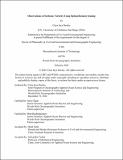Observations of Surfzone Vorticity Using Optical Remote Sensing
Author(s)
Dooley, Ciara Jaya
DownloadThesis PDF (35.32Mb)
Advisor
Elgar, Steve
Raubenheimer, Britt
Terms of use
Metadata
Show full item recordAbstract
The surfzone is the dynamic interface between the land and ocean, where waves shoal and break as they reach shallow water near the shore. Currents and circulation patterns in the surfzone transport sediment, nutrients, pollutants, and other materials along and across the coast, and can create hazardous conditions for swimmers (rip currents). However, understanding of the strength and structure of eddies and vortices in the flow field primarily remains limited to numerical models and theory. Here, novel observations of surfzone vorticity at small [O(10m)] and large [O(100m)] spatial scales are presented and related to incident wave conditions and the measured underlying bathymetry. Field experiments were conducted at a sandy beach on the Atlantic Ocean, and nearshore flows were observed using optical remote sensing (coastal imaging) and in situ sensors. Remote sensing algorithms are expanded from previous applications to estimate high spatial resolution two-dimensional surface flows by tracking the motion of naturally occurring foam throughout the surfzone. Estimated currents are correlated with in situ flow measurements, and errors increase as the sea-surface viewing angle becomes more oblique and image quality decreases. Large spatial-scale vorticity estimated using remotely sensed flows increases with alongshore bathymetric inhomogeneity, and complex circulation patterns corresponding to holes and channels in the seafloor persist for days at a time. Small spatial-scale vorticity estimated from a 5-m diameter ring of 14 current meters increases with the directional spread of the incident wave field, consistent with increased vorticity injection from the crest-ends of breaking waves. Small spatial-scale vorticity estimated using remotely sensed flows is spatially variable and correlated with the amount of wave breaking observed at a given location. Enhanced vorticity at large and small spatial scales occurs in the inner surfzone, and virtual drifters released into the remotely sensed flow fields demonstrate cross-shore variability in dispersion and mixing. This thesis expands the understanding of vorticity dynamics in the surfzone through unique field observations and provides new tools for coastal research and monitoring through development of remote sensing techniques.
Date issued
2025-02Department
Massachusetts Institute of Technology. Department of Civil and Environmental EngineeringPublisher
Massachusetts Institute of Technology